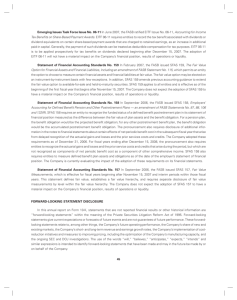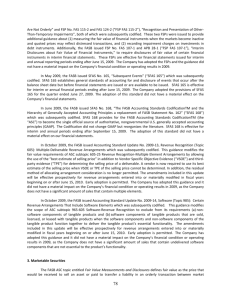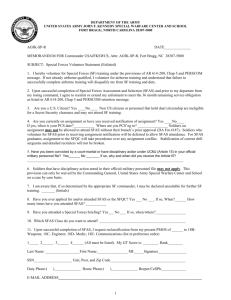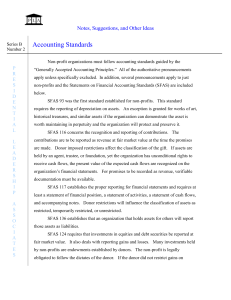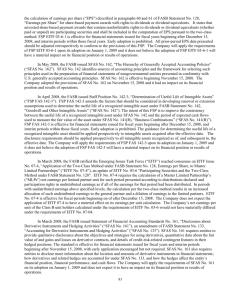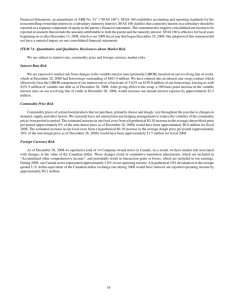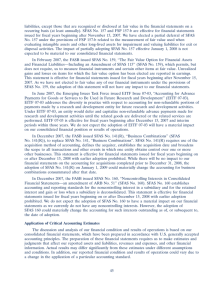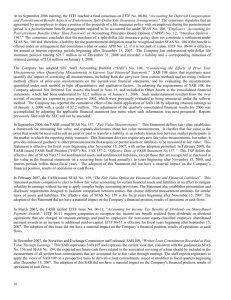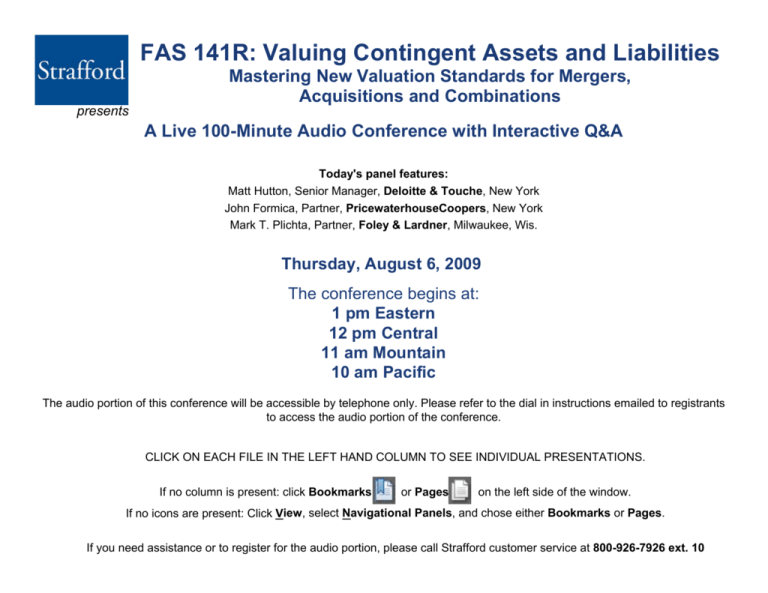
FAS 141R: Valuing Contingent Assets and Liabilities
Mastering New Valuation Standards for Mergers,
Acquisitions and Combinations
presents
A Live 100-Minute Audio Conference with Interactive Q&A
Today's panel features:
Matt Hutton, Senior Manager, Deloitte & Touche, New York
John Formica, Partner, PricewaterhouseCoopers, New York
Mark T. Plichta, Partner, Foley & Lardner, Milwaukee, Wis.
Thursday, August 6, 2009
The conference begins at:
1 pm Eastern
12 pm Central
11 am Mountain
10 am Pacific
The audio portion of this conference will be accessible by telephone only. Please refer to the dial in instructions emailed to registrants
to access the audio portion of the conference.
CLICK ON EACH FILE IN THE LEFT HAND COLUMN TO SEE INDIVIDUAL PRESENTATIONS.
If no column is present: click Bookmarks
or Pages
on the left side of the window.
If no icons are present: Click View, select Navigational Panels, and chose either Bookmarks or Pages.
If you need assistance or to register for the audio portion, please call Strafford customer service at 800-926-7926 ext. 10
FAS 141R: Valuing Contingent Assets and
Liabilities Teleconference
Aug. 6, 2009
Statements 141(R) and 160 –
New Accounting For Business
Combinations And NonControlling Interests
Implementation Issues
Matt Hutton, Deloitte & Touche
mhutton@deloitte.com
0
Agenda
Overview
Statement 141R – Implementation Issues
Statement 160 – Implementation Issues
This publication contains general information only and Deloitte is not, by means of this publication, rendering accounting, business, financial, investment,
legal, tax, or other professional advice or services. This publication is not a substitute for such professional advice or services, nor should it be used as a
basis for any decision or action that may affect your business. Before making any decision or taking any action that may affect your business, you should
consult a qualified professional advisor.
1
Overview
• Both standards became effective for calendar year-end companies as of
1/1/09
• Light M&A deal volume has led to limited “live” examples
• Too early to tell how practice is evolving, if at all, to the new rules
• 141R concepts are “creeping” into other areas of accounting
• FASB/EITF/SEC have been addressing implementation issues
2
Statement 141R –
Business Combinations
- Identifying transactions within its scope
- Determining purchase price
- Measuring assets acquired and liabilities assumed
3
141R – Definition Of A Business
Requirement…
• SFAS 141R expanded the definition of a business such that (1) it need not include all of the inputs or
processes that the seller used in operating that business if market participants are capable of acquiring the
business and continuing to produce outputs, for example, by integrating the business with their own inputs
and processes, and (2) outputs are not required for an integrated set of activities and assets to qualify as a
business
Issues…
• What is getting swept in now that might not have in the past?
• Since SFAS 141R says a business “need not include all of the inputs and processes,” does that imply that
the business needs to at least have some?
• What are the implications of this expanded definition to other pieces of literature?
Implementation guidance…
• Development stage enterprises, real-estate properties, individual retail stores or branches may all be swept
in under the revised definition
• While IFRS 3(R) is similar, some disagreement exists between US GAAP and IFRS practitioners on the
extent of inputs and processes needed
• More entities may qualify for the FIN 46R business scope exception
• SFAS 142 reporting units may need to be reassessed
– Could lead to different goodwill allocations (e.g. divestitures, impairments)
4
141R – Contingent Consideration
Requirement…
• SFAS 141R requires that the fair value of amounts to be issued be included in initial purchase price. If the
arrangement qualifies for equity treatment, no additional adjustment required. If the arrangement qualifies for
liability treatment, amount needs to be “marked” through the income statement until ultimately settled
Issues…
•
•
•
•
How do you actually qualify for equity treatment?
Is there a way to provide the seller with downside protection without jeopardizing equity treatment?
If equity treatment is not obtained, where does the “mark” get recorded?
How is the fair value of contingent consideration determined?
Implementation guidance…
• Obtaining equity treatment is not as easy as settling, or having the option to settle, in stock
– Is the arrangement a liability under SFAS 150?
– Is the arrangement indexed to the entity’s own stock (EITF 07-5)?
– Does the arrangement meet all of the criteria for equity classification (EITF 00-19)?
• Share price guarantees and/or puts added pressure on the SFAS 150 analysis
• Gains/losses should be treated as operating for purposes of the statements of operations and cash flows
• A discounted cash flows model is ordinarily applied to valuing contingent consideration
5
141R – Deal Fees
Requirement…
• SFAS 141R requires that direct and incremental costs (i.e., professional fees) be expensed as
incurred
Issues…
• How should a buyer account for fees paid to an investment banker for both advisory services
and underwriting in connection with a business combination or asset acquisition?
• How should a buyer account for deal costs incurred prior to adoption that will ultimately relate
to transactions closing subject to SFAS 141R?
Implementation guidance…
• When an investment banker is providing, in addition to transaction advisory services,
underwriting services associated with the issuance of debt or equity securities, total fees
incurred should be allocated on a relative fair value basis for purposes of accounting for
debt/equity issuance costs separate of deal costs
– Reminder: Debt issuance fees are still capitalized and equity issuance fees are still offset against equity
• SEC has indicated that it will accept any of the following three alternatives for pre-adoption deal
costs:
– Capitalize deal fees in the current year only if it is probable the acquisition to which they relate will close
prior to the adoption of SFAS 141R,
– Capitalize all deal fees in the current year; immediately expense any deferred deal fees relating to deals
in-process upon adoption of SFAS 141R, or
– Capitalize all deal fees in the current year; retrospectively adjust historical financials for a change in
accounting principle affecting deal fees relating to deals in-process upon adoption of SFAS 141R6
141R – Compensation
Requirement…
• SFAS 141R requires that – in the absence of a contractual requirement in the target’s share-based
compensation plans to do so – the acceleration of vesting of a share-based compensation award in a
business combination (i.e., the exchange of unvested awards of the target for either vested awards of the
buyer or cash) will result in an incremental charge in the buyer’s post-combination income statement
Issues…
• How do you decipher between pre-existing arrangements and new arrangements?
• What about split payments (e.g., 50% if there is a change in control, and 50% 1-year after a change in
control)?
Implementation guidance…
• The acquirer must evaluate each arrangement to determine whether it is compensation expense rather than
a payment for past services and meets the criteria for being part of the business combination transaction
• Factors that an entity may consider when making these determinations include (but are not limited to):
– What is the purpose of the payments?
– Who initiated the arrangement and who primarily benefits from it?
– When was the arrangement entered into?
7
141R – Indemnifications
Requirement…
• FAS 141R requires an acquirer recognize an indemnification asset at the same time that it recognizes the
indemnified item, measured on the same basis as the indemnified item, subject to the need for a valuation
allowance for uncollectible amounts
Issue…
• How should cash or shares escrowed at closing for (1) standard reps and warranties and/or (2) specific
indemnities be accounted for?
• How should an issuer reflect subsequent changes in a tax-related indemnification asset in the income
statement?
Implementation guidance…
• If the amounts in escrow are for standard reps and warranties, the entire escrow amount would typically be
recorded as purchase price since most standard reps and warranties are expected to settle without claim
• If the amounts in escrow are related to a specific indemnification (i.e., explicitly referenced in the purchase
agreement):
– Record the entire escrow amount as part of the purchase price
– Record a liability related to the indemnified item at fair value or otherwise depending on the applicable
guidance (i.e., FAS 5 and FIN 48), and a corresponding asset for the same amount
• While adjustments to income tax contingencies are a component to current tax expense (benefit),
adjustments to the related indemnification asset should be recorded outside of income tax expense (benefit)
8
141R – Fair Value Of Liabilities
Requirement…
• FAS 141R requires that most liabilities be fair valued
Issues…
• What is the appropriate discount rate to use for acquired debt?
• What happens to any differences between the fair value assigned in purchase accounting (i.e., as
determined by a discounted cash flows or other valuation model) and the ultimate payout amount?
Implementation guidance…
• Discount rate should be reflective of the terms of the deal
– Asset purchase – Rate of buyer
– Stock purchase – Rate of target, but need to consider “guarantees” – both explicit and implicit
• For debt items recorded at fair value, discounting will result in future accretion through interest expense
• For non-debt items recorded at fair value (e.g., warranties and liability classified contingent consideration),
discounting will result in future accretion expense through operating income
• Pre-acquisition contingencies accounted for in accordance with SFAS 5, rather than at fair value, would be
exempt from this issue
• Amounts may need to be modeled and planned for
9
141R – Defensive Intangible Assets
Requirement…
• SFAS 141R requires an acquirer to recognize an acquired asset and measure it at fair value in accordance
with SFAS 157, even if it decides not to use that acquired asset
Issues…
• What is a defensive intangible asset?
• How is a defensive intangible asset recorded?
• How is the useful life of a defensive intangible asset determined?
Implementation guidance…
• EITF 08-7 was issued to clarify the accounting around defensive intangible assets
• A defensive intangible asset is an asset an entity does not intend to actively use but intends to hold or “lockup” to prevent others from obtaining access to the asset
– Defensive assets can include assets that the acquirer will never actively use, as well as assets that will
be used by the acquirer during a transition period when the intention of the acquirer is to discontinue the
use of the assets
– Defensive assets have value to market participants
• A defensive value asset should be recognized as a separate unit of accounting and not added to the value of
a buyer’s pre-existing assets
• A defensive value asset should be assigned a useful life that reflects the entity’s consumption of the
expected benefits related to that asset
– Useful life is determined by estimating the period over which the defensive intangible asset will diminish
in fair value
10
141R – Other Observations
• SFAS 141R’s tax changes apply to all deals – not just prospective deals
• SFAS 141R requires retrospective adjustment of financial statements for changes in estimates used in
acquisition method of accounting; while not a “restatement,” this can still be a painful process, especially if
involved in a registration process or maintain active “open” registration statements (e.g. S-8)
• Recording receivables at fair value, instead of “present values of amounts to be received determined at
appropriate interest rates, less allowances for uncollectibililty…” has proved challenging for banking industry
• The fair value of a noncontrolling interest cannot ordinarily be implied from the price of the acquired interest
• Judgment must be applied in determining whether escrowed share arrangements, whereby the shares are
released upon the satisfaction of a contingency, are compensatory (EITF Topic D-110)
• EITF 09-2 tentatively concludes SFAS 141R’s IPR&D accounting is to be applied to asset acquisitions
• EITF 08-6 concludes that entities accounting for equity method investments should (1) determine the initial
carrying value of an equity method investment by applying Appendix D of SFAS 141R (i.e., deal fees may be
capitalized), and (2) account for subsequent share issuances of the investee as if the equity method investor
had sold a proportionate share of its investment (i.e., any gain or loss is recognized in earnings)
– Note: The Task Force considered whether to provide guidance on how the difference between the
investor's carrying value and the investor's share of the underlying equity of the investee should be
allocated, but decided not to address this issue. Practice should continue to follow the one-line item
purchase price allocation required by APB 18
11
Statement 160 –
Non-Controlling Interests
- Identifying transactions within its scope
- Resolving conflicts with pre-existing guidance
12
160 – Partial Sales Of Subsidiaries
Requirement…
• SFAS 160’s deconsolidation provisions, including the requirement to remeasure any retained noncontrolling interest to fair value, apply to a “subsidiary”
Issues…
Does this requirement apply to:
• The sale of a subsidiary that does not meet the definition of a business?
• The exchange of a group of assets that constitutes a business in exchange for an equity interest in
the purchaser or the transferred business?
• The sale of a subsidiary to an equity method investee?
• The contribution of a subsidiary to a joint venture?
• The sale of a subsidiary that is in-substance real estate?
Implementation guidance…
Under proposed guidance from the FASB:
• SFAS 160 would be modified such that it would only apply to subsidiaries that are businesses
• EITF 01-2 would be modified such that the exchange of a group of assets that constitute a business
(e.g., a carve-out) for an equity interest should follow the provisions of SFAS 160 (i.e., full versus
partial gain)
• SFAS 160 would apply when a subsidiary is transferred to an equity method investee
• SFAS 160 would apply to the formation of a joint venture
• Sales of interests in a subsidiary that is in-substance real estate would be accounted for in
accordance with SFAS 66 and related literature
13
160 – Contingent Consideration
Requirement…
• SFAS 160 requires that the fair value of “any consideration received” be included in the gain or loss on
deconsolidation of a subsidiary
Issues…
• Does that mean that contingent consideration received by a seller is no longer subject to the “gain
contingency” guidance in SFAS 5?
• If “yes,” what is the seller’s accounting on Day 2 if the contingent consideration arrangement does not meet
the definition of a derivative?
Implementation guidance…
• Yes. Need to record full fair value of what was received on Day 1, including fair value of contingent
consideration arrangement
• Day 2 accounting has been added to the EITF’s agenda (EITF 09-4)
– Certain Task Force members also recently suggested that EITF 09-4 should also include a
reconsideration of the seller’s initial accounting for the contingent consideration arrangement. Further
discussion is expected
14
160 – Changes In A Parent’s Ownership Interest
Requirement…
• SFAS 160 requires that changes in a parent’s ownership interest, while the parent retains its controlling
financial interest, are accounted for as equity transactions
Issues…
• How does this guidance interact with SAB Topic 5H, Accounting For Sales Of Stock By A Subsidiary?
• What is the treatment of transaction costs?
• What amounts, other than equity, must be reallocated between the controlling and non-controlling interest?
Implementation guidance…
• SEC has rescinded SAB Topic 5.H, which permitted gain recognition on the sale of subsidiary stock
• A parent’s direct costs to purchase and sell interests in a subsidiary should generally be recorded as an
adjustment to APIC (assuming parent retains control)
• Parent must reallocate accumulated other comprehensive income and goodwill impairments between the
controlling and non-controlling interests
15
160 – Other Observations
• Net income is bifurcated between the controlling and non-controlling interests as follows:
Net Income
xxx
Less: Net income attributable to the non-controlling interest
Net Income attributable to XYZ Company (i.e., Registrant)
(xx)
XXX
– EPS is calculated using “Net income attributable to XYZ Company”
– Cash flow statement begins with “Net Income,” as paragraph 6 of SFAS 95 was not modified
• Income should be allocated regardless of whether losses, prior to the adoption of SFAS 160, had been
allocated to the controlling interest because the non-controlling interest had been reduced to zero; the
controlling interest is not able to recoup previous, non-pro rata allocations of losses
16
Appendix –
Significant Changes Under 141R
17
Appendix: 141R – Significant Changes
Issue
SFAS 141
SFAS 141 (R)
Measurement date A reasonable period of time
for acquirer’s
before and after terms are
equity securities
agreed to and announced
Fair value at acquisition date
Restructuring and
exiting costs
Post combination expenses
Liability recognized in the
business combination
Adjustments to
Adjustments generally
certain income tax recorded to goodwill
balances
Adjustments recorded to
income tax expense
Indemnification
assets
No guidance on point; diversity Recognize and measure
in practice
based on the related liability
Negative goodwill
Pro-rata reduction of certain
long-lived assets
(extraordinary gain)
Value in purchase accounting
– immediately expense
IPR&D
No reduction of assets, record
as gain
Value in acquisition method
accounting – do not expense
18
Appendix: 141R – Significant Changes (Cont.)
Issue
SFAS 141
SFAS 141 (R)
Acquisition Costs
Capitalized and generally
Expense as incurred
recorded as a component of
goodwill
Contingent
Consideration
Generally record when
contingency is resolved
Record fair value at acquisition
date – liabilities remeasured to
fair value each period
Reacquired Rights Generally recorded at fair
value
Record at fair value for the
remaining contractual term (i.e.,
ignore renewals)
Measurement
Generally recorded
Period Adjustments prospectively
If material, retrospective
application required
Definition of a
business
Must have inputs,
processes, AND outputs.
Inputs, processes, and outputs
not necessarily required
Noncontrolling
Interest
Historical cost
Fair value
19
Circular 230 Notice
Any tax advice included in this written communication was not intended or written to be used, and it cannot be used by the
taxpayer, for the purpose of avoiding any penalties that may be imposed by any governmental taxing authority or agency.
Copyright © 2009 Deloitte Development LLC. All rights reserved.
Deloitte refers to one or more Deloitte Touche Tohmatsu, a Swiss Verein, and its network of member firms, each of which
is a legally separate and independent entity. Please see www.deloitte.com/us/about for a detailed description of the legal
structure of Deloitte Touche Tohmatsu and its member firms.
20
20
FAS 141R: Valuing Contingent Assets And
Liabilities Teleconference
Aug. 6, 2009
Business Combinations and Non-Controlling
Interests – FSP FAS 141(R)-1
John Formica, PricewaterhouseCoopers
john.r.formica@us.pwc.com
Agenda
Acquired Contingencies
•
Overview
•
Initial recognition and measurement
•
Subsequent measurement
•
Valuation
•
Disclosures
Loss Contingencies Disclosure Project
•
History
•
Project status and next steps
Acquired Contingencies
Overview
• FSP FAS 141(R)-1* was issued on April 1, 2009
• Amends and clarifies accounting for acquired contingencies
• Issued as a result of significant concerns from preparers, legal counsel, auditors,
etc.
• Same effective date as FAS 141(R)*
• Carries forward the guidance in FAS 141 without significant revision
_________________
* ASC 805
Slide 3
Acquired Contingencies (Cont.)
Overview (Cont.)
Exposure Draft
Fair value
FAS 141
Preliminary
FSP FAS 141(R)-1
Deliberations
Fair Value
Fair Value if determinable
FAS 141(R)
• Fair value
• Higher of
fair value or FAS 5 amount
Slide 4
Acquired Contingencies (Cont.)
Initial Recognition And Measurement
• On the acquisition date:
- Record at fair value, if determinable
- If not determinable, record if probable and reasonably estimable
- If above criteria are not met:
An asset or a liability can not be recorded
Acquirer should account for such assets or liabilities under FAS 5*
_________________
* ASC 450
Slide 5
Acquired Contingencies (Cont.)
Initial Recognition And Measurement (Cont.)
• More acquired contingencies (e.g., warranties) will likely be measured at fair value
- Availability of reliable information
- Existence of a long track record of history
- Market transactions
Slide 6
Acquired Contingencies (Cont.)
Initial Recognition And Measurement (Cont.)
•
FASB expects fair value of most legal contingencies will not be determined on acquisition date
•
Legal contingencies particularly difficult to record at fair value
•
-
Unpredictability of litigation
-
Lack of prior experience due to the unique nature of each lawsuit
-
Fair value estimates could change dramatically as new developments occur
-
Unlikely that fair value estimates will be predictive of the ultimate outcome in many cases
Likely that more contingent liabilities will likely be recorded than contingent assets
Slide 7
Acquired Contingencies (Cont.)
Subsequent Measurement (Cont.)
• Measured and accounted for using a systematic and rational basis, depending on
the nature
• Judgment will be required
• Companies need to develop policies for transitioning from initial measurement at
fair value to subsequent measurement at amounts other than fair value
Slide 8
Acquired Contingencies (Cont.)
Subsequent Measurement (Cont.)
•
For example, warranty obligations subsequent accounting may be similar to
guarantees
•
Guarantees are initially recognized at fair value under FIN 45*
•
Reduced, by a credit to earnings, as guarantor is released from risk under
guarantee
•
Release from risk typically recognized over term of guarantee
_________________
* ASC 460
Slide 9
Acquired Contingencies (Cont.)
Valuation
• Limited practical experience and guidance
• FAS 141(R) does not change valuation techniques that are used to value these
assets and liabilities
Slide 10
Acquired Contingencies
Disclosures
• The following disclosures shall be included in the business combination footnote:
- Acquired contingencies recognized at the acquisition date
Nature of the contingencies
Amounts recognized and measurement basis applied
- For contingencies not recognized at the acquisition date
Disclosures required by FAS 5, if occurrence of the contingencies are deemed
reasonably possible
o
Nature of the contingencies
o
Estimate of range of outcomes, or
o
If no estimate can be made, disclose that fact
- An acquirer may aggregate disclosures for assets or liabilities arising from contingencies
that are similar in nature
Slide 11
Loss Contingencies Disclosure Project
Loss Contingency Disclosures Project
History
• In 2008, the FASB issued an exposure draft
- Investor concerns that current disclosures are inadequate and untimely
- Not recognition/ measurement
- Expanded disclosures
- Enable investors and other users of corporate financial statements to assess the
likelihood, timing and amount of future cash flows associated with loss
contingencies
Slide 13
Loss Contingency Disclosures Project (Cont.)
History (Cont.)
Proposed disclosures would have:
• Required enhanced quantitative and qualitative disclosures (e.g., gross amount of
claim or estimate of the maximum exposure to loss)
• Required a reconciliation of loss contingencies in the aggregate, at the beginning
and end of the period
• Enhanced disclosures for insurance and indemnification arrangements
• Provided a limited prejudicial exemption
Slide 14
Loss Contingency Disclosures Project (Cont.)
History (Cont.)
• Comment period ended on Aug. 8, 2008
• Significant interest from broad range of constituents
- 240 comment letters
- Substantial majority not supportive of proposal
- FASB has delayed the proposal’s effective date
Slide 15
Loss Contingency Disclosures Project (Cont.)
Project Status And Next Steps (Cont.)
• Update since exposure draft
- Evaluation of comment letters
- Field testing complete
- Roundtable discussions - March 6, 2009 including users, preparers, ABA, regulators,
auditors, FASB, IASB
• Next steps
- Re-deliberations in Q3
- Update project plan and timetable to be developed
- Effective date not expected prior to the end of 2009
Slide 16
© 2009 PricewaterhouseCoopers LLP. All rights reserved. "PricewaterhouseCoopers" refers to
PricewaterhouseCoopers LLP (a Delaware limited liability partnership) or, as the context requires, the
PricewaterhouseCoopers global network or other member firms of the network, each of which is a separate and
independent legal entity.
FAS 141R: Valuing Contingent Assets
And Liabilities Teleconference
Aug. 6, 2009
Contingent Litigation Liabilities Under
FSP 141R-1
Mark Plichta, Foley & Lardner
mplichta@foley.com
©2009 Foley & Lardner LLP • Attorney Advertising • Prior results do not guarantee a similar outcome • Models used are not
clients but may be representative of clients • 321 N. Clark Street, Suite 2800, Chicago, IL 60654 • 312.832.4500
2
Recognition Of Contingent Litigation
Liabilities Under FSP 141R-1
Criteria if liability cannot be determined during
measurement period
– Information before the end of the measurement period indicates
that it is probable that a liability had been incurred at the
acquisition date
– The amount of the liability can be reasonably estimated
Similar to traditional FAS 5 standard
Specifically adopts guidance from FAS 5 and FASB
Interpretation No. 14
©2009 Foley & Lardner LLP
3
Legal View
Most litigation should not result in recognition of a liability under
FAS 5 (or FSP 141R-1) due to uncertainties of litigation
ABA policy for responses to auditor letters
– In view of the inherent uncertainties, the lawyer should normally refrain
from expressing judgments as to outcome except in those relatively few
clear cases where it appears to the lawyer than an unfavorable
outcome is either “probable” or “remote”
©2009 Foley & Lardner LLP
Probable – an unfavorable outcome for the client is probable if the prospects
of the claimant not succeeding are judged to be extremely doubtful and the
prospects for success by the client in its defense are judged to be slight
Remote – an unfavorable outcome is remote if the prospects for the client
not succeeding in its defense are judged to be extremely doubtful and the
prospects of success by the claimant are judged to be slight
For this limited purpose, the ABA’s definitions of “probable” and “remote”
differ from FAS 5
4
Legal View (Cont.)
Range
– The amount or range of potential loss will normally be as
inherently impossible to ascertain, with any degree of certainty,
as the outcome of the litigation
– Therefore, it is appropriate for the lawyer to provide an estimate
of the amount or range of potential loss (if the outcome should
be unfavorable) only if he believes that the probability of
inaccuracy of the estimate of the amount or range of potential
loss is slight (emphasis added)
Practical concern with abandoned FAS 5/141R exposure
draft: The ABA policy would not allow attorneys to
provide information to companies/auditors that auditors
might conclude is necessary to give a clean opinion
©2009 Foley & Lardner LLP
5
Reasons For Not Expanding
Disclosure By Companies/Attorney
Difficulty predicting litigation outcomes
Facts can be misleading (e.g. claim amounts)
Road map for opposing litigants and counsel
Attorney-client privilege
Attorney work product
©2009 Foley & Lardner LLP
6
Attorney-Client Privilege And
Attorney Work Product
Attorney-client privilege protects confidential
communication between an attorney and client made for
the purpose of obtaining professional legal advice and
assistance
Attorney work product doctrine protects documents and
theories prepared by an attorney in the course of an
investigation if litigation is pending or is anticipated
If privilege or doctrine is waived, applicable information
becomes discoverable by adversary in litigation
©2009 Foley & Lardner LLP
7
Attorney-Client Privilege And
Attorney Work Product (Cont.)
Disclosure to third parties, including auditors, waives
privilege
Disclosure to adversary in litigation, including in public
company financial statements, waives work product
doctrine
No clear consensus regarding whether disclosure to
auditors waives work product doctrine, but majority of
cases say it does not
©2009 Foley & Lardner LLP
8
What Is To Come?
FASB disclosure project
Round table held on March 6, 2009
– Two general approaches to disclosure: Predictive or
additional facts
– Minutes suggest participants still struggled trying to
balance the issues noted earlier
©2009 Foley & Lardner LLP
Click here for the text of FSP FAS 141R-1:
http://www.fasb.org/cs/BlobServer?blobcol=urldata&blobtable=MungoBlobs&blobkey=id&blob
where=1175818779968&blobheader=application%2Fpdf
Click here for the text of FAS 141R:
http://www.fasb.org/cs/BlobServer?blobcol=urldata&blobtable=MungoBlobs&blobkey=id&blob
where=1175818828579&blobheader=application%2Fpdf
Click here for the text of FAS 160:
http://www.fasb.org/cs/BlobServer?blobcol=urldata&blobtable=MungoBlobs&blobkey=id&blob
where=1175818748980&blobheader=application%2Fpdf

